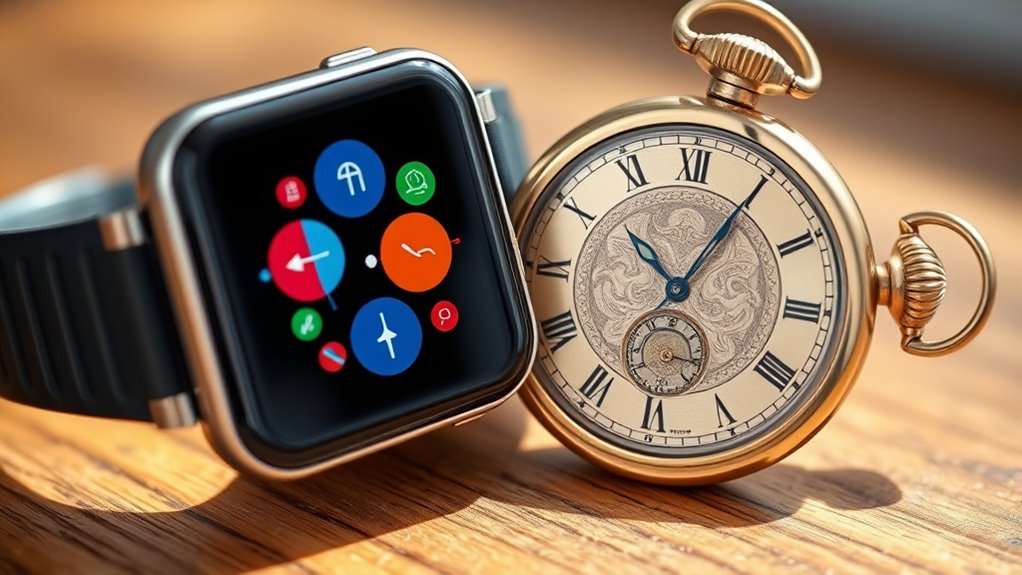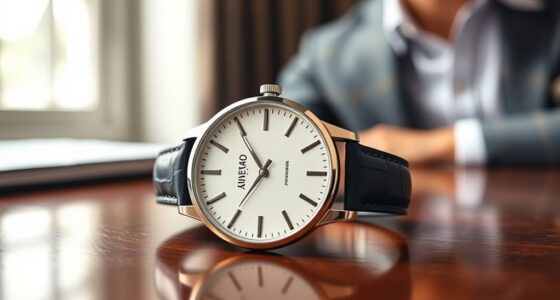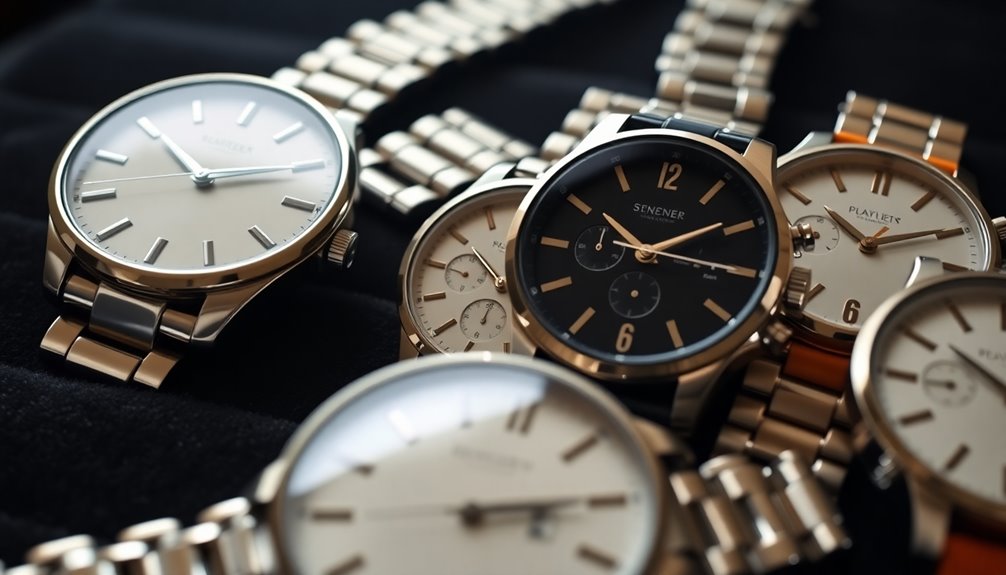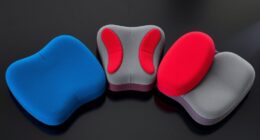Smartwatches are reshaping how you view and use time, but they don’t necessarily threaten Swiss timepieces. Instead, they complement each other by serving different needs: smartwatches offer convenience, connectivity, and health features, while Swiss watches symbolize craftsmanship, luxury, and investment. Both cater to distinct lifestyles and values, creating a dual market. If you want to understand how these two worlds coexist and influence each other, there’s more to explore.
Key Takeaways
- Smartwatches challenge traditional horology but are largely seen as complementary, serving different consumer needs and preferences.
- Swiss watchmakers are integrating smart features to preserve heritage while appealing to modern, tech-savvy buyers.
- The market is evolving into a dual landscape: luxury traditional timepieces and casual, connected smartwatches.
- Smartwatches enhance convenience and connectivity, whereas Swiss watches symbolize craftsmanship, exclusivity, and investment value.
- The rise of smartwatches encourages innovation in Swiss watchmaking, creating opportunities rather than threats for the industry.
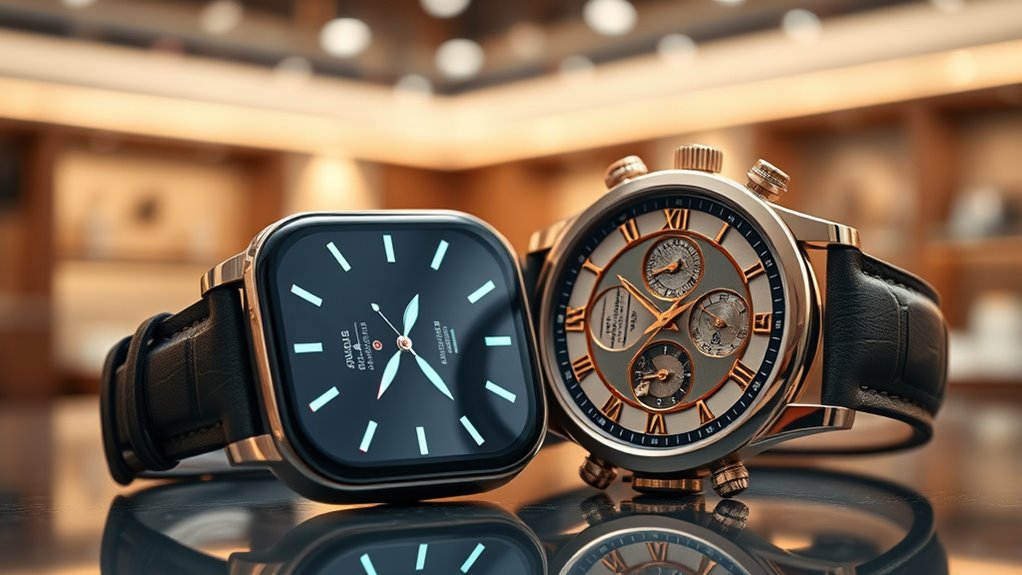
In recent years, smartwatches have revolutionized the way we tell time, blending advanced technology with everyday convenience. You might think this shift poses a threat to traditional Swiss timepieces, but it also opens new avenues for both worlds to coexist. As a consumer, you’re faced with choices that reflect innovation, status, and personal style. The rise of smartwatches isn’t just about digital convenience; it’s also influencing how luxury brands position themselves in a competitive market. Many high-end watchmakers are embracing technological innovation, integrating smart features into their classic designs or collaborating with tech giants to create hybrid products. This fusion maintains the heritage and craftsmanship of Swiss timepieces while appealing to the modern, tech-savvy consumer. Additionally, the digital transformation of watchmaking encourages brands to rethink their strategies, blending tradition with innovation to stay relevant. Luxury branding plays an essential role in this dynamic. Swiss watchmakers have long built their reputation on exclusivity, precision, and timeless elegance. Now, they’re leveraging technological innovation to enhance these qualities rather than replace them. For example, some brands incorporate smart technology into their traditional collections, offering models that combine the allure of Swiss craftsmanship with functionalities like health tracking, notifications, or even augmented reality features. This approach caters to customers who want both the prestige of a luxury watch and the practicality of modern technology. It helps preserve the status and desirability associated with Swiss brands while demonstrating their adaptability in a digital age. You may wonder if smartwatches threaten the essence of Swiss timepieces. While they certainly challenge traditional notions of horology, many see them as complementary rather than adversarial. Smartwatches excel in convenience and connectivity, making them ideal for everyday wear, fitness tracking, or quick notifications. Meanwhile, Swiss watches stand out as symbols of craftsmanship, heritage, and investment. For collectors and enthusiasts, the appeal of owning a finely crafted mechanical watch remains unmatched. As a result, the market is evolving into a dual landscape: one where tech-driven smartwatches dominate casual use, and Swiss timepieces continue to symbolize luxury, tradition, and artistry. Ultimately, the rise of smartwatches doesn’t mean the end of Swiss timepieces. Instead, it challenges traditional brands to innovate and redefine what luxury means in a digital era. For you, this dynamic offers more options—whether you prioritize cutting-edge technology or timeless elegance. Both can coexist, each serving different purposes and resonating with different values. As the lines blur between tradition and innovation, you’re empowered to choose a timepiece that best reflects your lifestyle and identity, embracing a future where technology and tradition work hand in hand.
Frequently Asked Questions
How Do Smartwatches Impact Traditional Watchmaking Craftsmanship?
Smartwatches influence traditional watchmaking craftsmanship by highlighting the value of handcrafted techniques and mechanical artistry. While smartwatches offer modern convenience, they can overshadow the intricate skill involved in creating mechanical timepieces. You appreciate how handcrafted techniques preserve the artistry, but smartwatches challenge this tradition by focusing on digital innovation. Ultimately, they can serve as a reminder to cherish the craftsmanship that defines Swiss watchmaking’s timeless appeal.
Are Smartwatches More Environmentally Friendly Than Swiss Watches?
You might find smartwatches more eco-friendly since they typically incorporate recycling programs and sustainable material sourcing, reducing waste and environmental impact. While Swiss watches are crafted with high-quality materials, their manufacturing processes often involve resource-intensive steps. Smartwatches’ ability to be updated digitally extends their lifespan, and their emphasis on eco-conscious practices can make them a greener choice, allowing you to enjoy innovation without compromising the planet’s health.
Can Smartwatches Be Considered Luxury Items Like Swiss Timepieces?
You might wonder if smartwatches can truly be considered luxury items like Swiss timepieces. While they boast impressive digital status and modern features, their brand perception often leans toward practicality rather than exclusivity. Unlike Swiss watches, which symbolize craftsmanship and tradition, smartwatches are seen more as functional gadgets. However, high-end brands are beginning to offer luxury smartwatches, blurring the lines between digital innovation and luxury status.
How Do Consumer Preferences Differ Between Smartwatches and Swiss Watches?
You notice that consumer preferences differ between smartwatches and Swiss watches mainly due to fashion trends and technological integration. While some prioritize the sleek, modern look of smartwatches with features like fitness tracking, others value the craftsmanship and timeless style of Swiss timepieces. You’re drawn to smartwatches for their practicality and innovation, but still appreciate Swiss watches for their heritage and luxury appeal, reflecting diverse tastes in the watch market.
What Legal Regulations Exist for Smartwatches Versus Swiss Watch Brands?
You’re diving into a legal landscape that’s as complex as a Swiss watch’s gears. Patent laws protect innovations, while import tariffs can make smartwatches more expensive to bring into markets. Swiss watch brands face strict regulations on trademarks and quality standards, whereas smartwatches are governed by consumer electronics laws and data privacy regulations. Both must adhere to these rules to operate legally, ensuring fair competition and consumer safety.
Conclusion
As you stand at the crossroads of tradition and innovation, remember that smartwatches are like the dawn breaking over a timeless mountain range. They bring new light, but the majestic peaks of Swiss timepieces still stand strong, whispering stories of craft and heritage. Whether you embrace the future or hold onto the past, know that both can coexist, each adding its unique melody to the symphony of time. The choice is yours—carry the legacy or shape the new horizon.
